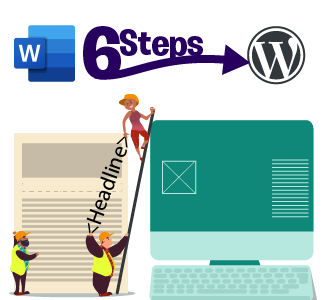Good web design is an experience.
Good web design is not just about planning—good web design is an experience for the user.
The best web design creates an environment where users feel they have just enough control over the experience that they feel empowered, but not so much control that they feel overwhelmed.
Designing the experience that’s right for the target customer is critical to running a successful website.
It’s also the criteria that the web browsers use to determine how successful your business will be.
Take Twitter, for example. It’s not winning design awards, and yet it’s undeniably and profoundly popular.
Twitter’s popularity is mainly due to two main things: The first is about telling your friends what you’re up to—executed simply without any bells, whistles, or decoration.
The second thing is about letting users have enough control over the experience to make them feel as if they’re expressing themselves—but without creating an overwhelming or intimidating experience.
For example, users can customise their backgrounds and a few colours on the page, but they don’t have to be Web designers to achieve something unique.
In a way, having a good design for your website is like having the power to catch lightning in a bottle. It not only builds your brand, but conveys authority and a superior experience for your users.
This article will show you how to think like any good web designer.
Elements of Website Usability
Usability means how easy it is for users to learn, engage with, and get satisfaction, from a website.
While the usability diagrams are helpful for a designer to plan out a Web site, usability level also comes from a variety of other factors from design, server speed, technology usage, and animation.
Usability is about the user. Usability is directly related to the experience a user has with a site—the better the usability, the better the experience is likely to be.
Some factors that influence the level of usability include:
- The purpose of a site: Is the site meant to entertain, or to inform?
- The needs and experience level of the user: How savvy is he or she?
- The technology that’s available: Is there new technology that could make finding information easier?
1. Simplicity
Simplicity can have three key effects on web design.
It increases the legibility of the design.
White spaces, or negative space refers to the zone between lines and characters, can make text much easier to scan.
White space helps to guide users towards the most important parts of a design.
It also allows readers to quickly get the information they want, by making it easy for them to scan through the design.
It improves first impressions for your business
Having a website that lets users to scan quickly makes a better impression for today’s users, who has limited time and attention span.
When your design helps them access what they want quickly, they can appreciate it. Simple designs doesn’t repeat themselves, nor do they overcrowd the page with filler.
It is easier to amend or update simple designs
Only elements like colours, fonts, and text requires altering whenever a website that has a simple design needs to be refreshed,
On the other hand, when a website gets overly complicated, you’ll find that there are a ton of elements to change out when a design is updated.
Adding unnecessary design elements that serve no functional purpose to your website will only make it harder for visitors to fulfil that purpose and drive them away.
You can implement elements of simplicity in many different ways. Here are some examples:
- Colours. Don’t use too many. You should be using only up to 3 or 5 colours on your entire website. different colours in your website’s design.
- Typefaces. The typefaces you choose should be legible on all types of screens, including desktops and smartphone devices.
- Graphics. Use graphics in a meaningful manner. Such as to illustrate a process clearly, or to increase readability. Only use graphics if they’ll help a user complete a task or perform a specific function
2. Visual Hierarchy
Visual hierarchy involves arranging and placing website elements in such a way that visitors will naturally gravitate toward the most important elements first, such as your CTA.
Remember, when optimising your website for usability and UX, the end goal is to guide visitors to complete the desired call-to-action (CTA), but in a way that feels natural and enjoyable.
To achieve hierarchy, designers use a focal point—an area in the composition that is perceived before all others.
For example, if you visit Apple.com, you’ll notice the first thing that draws your attention is the image of the iPhone sitting above the fold.
It immediately presents you an impactful visual presentation so you quickly focus towards their CTA.
The reason why this works is simply because the human eye moves toward large objects first.
It’s a basic visual hierarchy web design principle which influences the content creation: larger size draws more attention.
Newspapers and magazines have been using this technique effectively for decades, placing their strongest message in the larger elements
3. Navigation
You’ll often hear about segmentation when it comes to email marketing.
In a nutshell, email segmentation means splitting your email subscribers based on their actions.
For example, you have 2 products for sale. Some customers bought either product A or B, but there are some that purchased both A and B.
This tells you that those that bought A and B are likely to buy again from you, and you should focus more attention on them.
This is just one of the countless way you can segment your list. Segmenting your email list allows you to retain customers since you are more likely to send the right emails at the right time.
When you are sending emails that are too generic and not relevantly based on the customer’s interaction, they are much less likely to be engaged.
For example, if you ‘ve stayed at a hotel in Paris, but I’ve received an email asking me ‘How was your stay in Europe?’, you’re more likely to ignore this email or other future communications because they are not relevant.
This is why segmentation is so vital to customer retention. If you send bulk emails to your entire email list without targeting specific segments, you’ll end up with a massive unsubscribe rate.
Segmenting based on the previous actions of your subscribers and customers is a much better way to retain them, and keep them interested.
Having instinctive navigation on your site is crucial, because it lets visitors find what want.
In the best case scenario, visitors to your website should be able to land there and not having to think at all.
Show extensively to your visitors where they should click next – tell them what to do to move from point X to point Y, with as little frustrations as possible.
There are s few ways you can do to optimise your site’s navigation:
- Ensure the structure of your website navigation layout simple (preferably towards the top of your page).
- Include navigation menu at the footer of your site.
- Use breadcrumbs and tags on every page (except for the homepage) so people know where they are on your website.
- Place a search box field near so visitors can search by keywords.
- Don’t overwhelm visitors with too many navigation options on a page.
- Don’t dig too deep. In most cases, it’s most ideal to keep your navigation to no more than three clicks away from the landing page.
- Include helpful links inside your page copy, and clearly indicate where these links lead to.
If you operate a large scale website and have a ton of web pages, you should categorise your content into main sections, then use a cascading system of menus either with drop-down lists or sub-menus.
Or you can break up the list of choices into the most important items (primary navigation) and the lesser important items (secondary navigation).
In either case, six groups of five are much easier to comprehend than one group of thirty.
Navigational elements also need to visually stand apart from the rest of the elements on the page and indicate that the user can click on them.
Use a system of different colours for active links, and links that the user has already visited. This system should be easy for the user to learn and should remain consistent throughout the entire site.
4. Consistency
Consistency is another golden rule in web design.
To provide a quality experience for your users it is essential that you are consistent in both the design and content of your websites.
Imagine you’re going to work, just like you do every day. You wear a suit, pick up your keys from the table, pick up your briefcase, get into your car and drive off.
It didn’t take you hours to know where your suit, keys and car is, because they’re always where they have been. They have been at the same place they’ve always been since yesterday, last week and the week before.
The reason why you can finish this task effortlessly, almost subconsciously, is because it was a consistent design experience.
This is the same type of experience that you have to provide for your website visitors.
And that means using the same backgrounds, colour schemes, typefaces, interactions and even the tone of your writing are consistent in all areas of your website.
But that doesn’t mean every page on your site should have the same exact layout.
Instead, you should create different layouts for specific types of pages (e.g., a layout for landing pages, a layout for informational pages, etc.).
By using those layouts consistently, you’ll make it much more accessible for visitors, and help them to understand what type of information they’re likely to find on a given page.
5. Responsiveness
You should always consider the needs users who are visiting your website, such as smartphone and tablet users.
So to give your visitors a truly great user experience, your site needs to be compatible with the different devices (and operating systems, and browsers) that your visitors are using.
And that means adopting a website structure that is highly flexible — like responsive design.
Responsive web design is an approach that allows design and code to respond to the size of a device’s screen.
This means a responsive website gives you the best viewing experience on any device. Whether you’re looking at the website on an old iPhone 5, your Android tablet or on a 40-inch television.
Other than displaying your website properly, you need to consider the design of tappable elements on your website too.
According to Apple, the comfortable minimum size of tappable UI elements on a smartphone screen is 44 x 44px. But this limit is often broken and the real world estimate limit is around 25px.
With responsive design, complex desktop UI can quickly adapt itself to a small mobile screen.
Remember, the design has to be flexible so it creates a great experience across all devices for users.
6. Credibility
Good website design establishes credibility for your business.’
When a visitors first opens your website, they’re having a gut reaction to your design. They’re deciding whether it’s credible or not.
As it turns out, the design of a website is the number 1 factor that determines whether visitors will find your site credible or not. Can users trust the information you provide? Can they trust the services you offer?
There is no specific rules to designing a highly credible website. Even designers find it hard to be specific to nail down the exact visual design cues to convey credibility.
However, here are some guidelines you should follow to stick to:
- Just use one (quality, appropriate) font and avoid using too many font styles.
- Use just a few font sizes throughout your site.
- Use only a single dominant color, while keeping the rest black, white, and gray
- Put more thought into creating white space across your website.
7. Speed
When it comes to speed, being fast is of the essence now more than ever in web design.
Your website visitors want to have a blazingly fast site experience, and if you don’t deliver fast enough, they’ll go somewhere else where they can.
While most of the website’s speed is dependant on the backend of your website like web host and object rendering, using good design can also help give your website a much-needed boost in loading time.
You can save yourself from future website speed headaches if you act smartly from the beginning of your design phase, and avoid harmful practices that will affect your site’s loading speed in the future.
Some of the minimalistic features includes:
A simple menu instead of a standard navigation bar
Using lots of white or negative space
Short and concise web forms
Images with small file sizes
Using a single font type instead of 2 or more types of fonts on your site
Another way is to give the perception of speed. In design, perception equals reality.
This means that if the design looks like they’re highly usable, you don’t need your website to load at lightning speed to produce high levels of user satisfaction or a perception of a friendly user interface.
In other words, although having a fast site is very important, but you can still create the perception of a faster site to keep your users happy.
So, if you don’t have the time or expertise to implement complicated technical solutions to improve your speed, try using good design instead and make your site seem faster than it looks.
8. Colour Palette
Deciding on a colour scheme palette for your website should never be done at random.
You should pay close attention to finding the right colours that fit the industry, culture, branding, and the ideas of your business.
There are many other things you need to keep in mind when picking the right colour combinations for your website design.
Like choosing a colour scheme that lasts for a long time rather than blindly following current trends.
The first thing you need to think about is who your audience is. Just because a popular website uses a great colour combination it doesn’t mean you can use it for your design.
If your website targets an international audience, you should try to pick colours that fit in with different cultures and ethnicities.
For example, while in western countries the colour Black represents luxury and boldness. In Indian culture, the same colour represents evil, negativity, and lack of energy.
More importantly, you need to find colours that represent your brand.
After all, the primary goal of your website design should be to send your brand or business message across to the visitors.
So, choose your colours to help achieve that goal by using the brand colours with a mix of the colour psychology.
Closing words
When you are coming up with the design choices of your website, think about how it can affect the emotions and the impression you are conveying to your visitors.
If you are clueless about how you should design your site, sit down and talk to your web designer. Find out how you can provide the best experience for anyone who visits your site.







